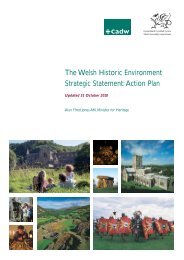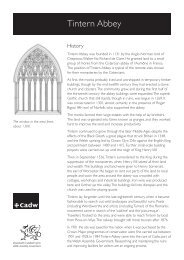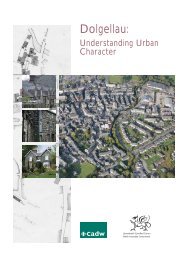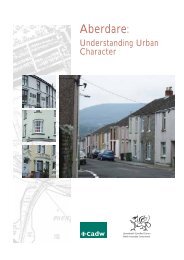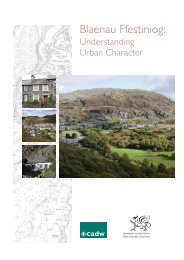Conwy Castle - Notes for Teachers [pdf, 506kb] - Cadw
Conwy Castle - Notes for Teachers [pdf, 506kb] - Cadw
Conwy Castle - Notes for Teachers [pdf, 506kb] - Cadw
Create successful ePaper yourself
Turn your PDF publications into a flip-book with our unique Google optimized e-Paper software.
A reconstruction of the<br />
machicolations in the west<br />
barbican, showing the way they<br />
may have been used during an<br />
attack or siege upon the gateway<br />
leading to the outer ward.<br />
<strong>Conwy</strong> <strong>Castle</strong><br />
<strong>Conwy</strong> <strong>Castle</strong> is one of the ring of castles built by Edward I to rule<br />
north Wales after he defeated the Welsh princes. A walled town <strong>for</strong><br />
English settlers was established at the same time.The walls and castle<br />
are remarkably complete and, along with Caernarfon <strong>Castle</strong> and town<br />
wall, Harlech <strong>Castle</strong> and Beaumaris <strong>Castle</strong>, in 1987 they were added<br />
to the World Heritage List of sites of outstanding value.<br />
History<br />
<strong>Conwy</strong> <strong>Castle</strong>, built on a rocky outcrop, controls the crossing of the river<br />
<strong>Conwy</strong>, at the eastern edge of Gwynedd. Edward I personally oversaw<br />
the planning of the castle and town early in 1283, and the work was<br />
supervised by Master James of St George, one of the greatest military<br />
architects of his day. In summer 1285, 1,500 workmen were employed,<br />
and two years later the work was largely completed. In such an exposed<br />
position, the building soon began to decay. In 1332 it was said to be not fit<br />
<strong>for</strong> the king to stay in. In 1346 the buildings were re-roofed in lead. In the<br />
great hall range, stone arches strong enough to support a lead roof replaced<br />
the previous timber trusses.The castle was seized by followers of Owain<br />
Glyn Dwˆ r in 1401. Little maintenance seems to have been carried out until<br />
the castle was repaired by supporters of the king in the Civil War.After that,<br />
the roof was removed.The castle was attractive to artists in the eighteenth<br />
century and it was painted by J. M.W.Turner.When Thomas Tel<strong>for</strong>d’s road<br />
bridge and later the railway brought visitors to <strong>Conwy</strong>, more interest was<br />
shown in the castle. It was given to the borough in 1865 and is now in the<br />
care of <strong>Cadw</strong>, on behalf of the National Assembly <strong>for</strong> Wales.A continuous<br />
programme of research and maintenance is carried out.<br />
Looking at the buildings<br />
The exterior<br />
• Look at the siting of the castle and its relationship to the river<br />
and town walls.<br />
• Is there evidence that the castle was built in a single phase?<br />
• Look <strong>for</strong> patches of limewash, which show that the castle was painted white.<br />
• Putlog holes: these round holes, visible in the tower walls, show where<br />
the scaffolding was.<br />
• Square holes beneath the battlements are evidence <strong>for</strong> a hourd,<br />
or wooden plat<strong>for</strong>m.<br />
• Arrowloops at alternating heights improve defence.<br />
• Notice the turrets on the four eastern towers.
Site of Ramp<br />
Town Wall<br />
Site of<br />
Drawbridge<br />
South-West<br />
Tower<br />
S i t e o f D i t c h<br />
West<br />
Barbican<br />
Modern Path<br />
North-West Tower<br />
Gate-passage<br />
Lesser<br />
Hall<br />
Ante-room<br />
N<br />
Site of Kitchen and Stables<br />
Outer Ward<br />
Porch<br />
Great Hall<br />
Prison<br />
Tower<br />
Kitchen<br />
Tower<br />
Passage<br />
Chapel<br />
Town Wall<br />
Site of<br />
Drawbridge<br />
Well<br />
Stockhouse<br />
Tower<br />
The outer gate and west barbican<br />
• The present entrance is modern.The original was via a ramp<br />
to the right.<br />
• Notice the grooves <strong>for</strong> a portcullis and pivot holes <strong>for</strong> a drawbridge<br />
in the outer gate.<br />
• There are drawbar holes <strong>for</strong> doors at the end of the gate-passage.<br />
• Large arrowloops and machicolations protect the gateway to the<br />
outer ward.<br />
The outer ward<br />
Bakehouse<br />
Tower<br />
• This is where the garrison lived, and in 1284 this comprised fifteen<br />
crossbowmen and fifteen other servants.<br />
• Notice evidence <strong>for</strong> a portcullis and a drawbar in the gateway.<br />
• The kitchen, stable and guardroom were built of timber against<br />
the north wall. Notice the foundations and stone corbels to support<br />
the roof in the wall.<br />
The great hall range<br />
Stockhouse<br />
Tower<br />
Site of<br />
Granary<br />
Bakehouse<br />
Tower<br />
Chapel<br />
Tower<br />
• These were grand rooms: notice the fine windows and door frames.<br />
• There are three fireplaces in this range.<br />
3<br />
Stairs to<br />
Water Gate<br />
4<br />
Inner<br />
Ward 7?<br />
East Barbican<br />
6<br />
5<br />
2<br />
King’s<br />
Tower<br />
Chapel<br />
Tower<br />
King’s<br />
Tower<br />
• The stone arches were built to support the new lead roof in 1346.<br />
1<br />
Upstanding Walls/Visible Foundations<br />
Buried/Lost Walls<br />
Names of Inner Ward Rooms<br />
Derived from 1627 Survey<br />
(Public Record Office, SP 16/89/25)<br />
1 The Great Chamber<br />
2 The Presence Chamber<br />
3 The Privy Chamber<br />
4 A Large Arched Roome used <strong>for</strong> a Cellar<br />
5 A Like Large Roome used <strong>for</strong> a Kitchen<br />
6 A Faire Lowe Parlor<br />
7 A Litle Roome used as a Buttery (?)<br />
0 10 20 30 Metres<br />
0 25 50 75 100 Feet
13<br />
12<br />
Mount Pleasant<br />
11<br />
Y Porth<br />
Uchaf<br />
(a’r bont) 14<br />
10<br />
Upper Gate Street<br />
Rosemary Lane<br />
15<br />
0 50 100 Metrau<br />
0 100 200 300 Troedfeddi<br />
9<br />
8<br />
Town Ditch Road<br />
16<br />
7<br />
Plas Mawr<br />
Lancaster<br />
Square<br />
6<br />
Chapel Street<br />
Porth<br />
17 18<br />
y Felin<br />
19<br />
5<br />
High Street<br />
Porth yr Adain<br />
Berry Street<br />
A f o n C o n w y<br />
Porth<br />
y Gilddor<br />
The new-style <strong>Conwy</strong> <strong>Castle</strong><br />
guidebook contains in<strong>for</strong>mation<br />
about the history of <strong>Conwy</strong> and<br />
reconstruction drawings of the<br />
buildings. It is available at 25%<br />
discount <strong>for</strong> educational use<br />
from <strong>Cadw</strong> Sales.<br />
Tel 01443 336 092/094<br />
Email cadw.sales@wales.gsi.gov.uk<br />
4<br />
Eglwys<br />
y Santes Fair<br />
Rose Hill Street<br />
Y Porth<br />
Isaf<br />
<strong>Castle</strong> Street<br />
20<br />
3<br />
2<br />
21<br />
1<br />
Castell<br />
Afon Gyffin<br />
G<br />
The towers<br />
• The north-west and south-west towers were the home<br />
of the constable and his family.<br />
• Notice the fireplaces and latrines.<br />
• The basements were used <strong>for</strong> storage.<br />
• The prison tower had a cell in the basement.<br />
The inner ward<br />
• This was ‘a castle within a castle’, containing the apartments<br />
of the king and queen.<br />
• From the castle it was reached over a drawbridge.<br />
• It could be entered from the east barbican without passing<br />
through the outer ward.<br />
• The towers have turrets.<br />
• There are some fine windows.<br />
• Some original plaster survives on the walls.<br />
• The chapel is the best preserved in the Edwardian castles.<br />
The town walls<br />
• Edward I divided the Welsh territory into English-style counties<br />
and <strong>Conwy</strong> was designed to be a county town.<br />
• The whole circuit of the town walls survives, although new<br />
openings have been made <strong>for</strong> roads and the railway.<br />
• The walls are 1,400 yards (1.3km) long, with twenty-one<br />
towers roughly 80 yards (46m) apart.<br />
• There are three defended gates and a row of twelve latrines.<br />
• There is a good view of the walls and the castle from Tower 13.<br />
Some ideas <strong>for</strong> site activities<br />
The castle as a stronghold<br />
• From the outside, what is most impressive about the castle?<br />
Does everyone agree?<br />
• What obstacles face attackers trying to reach the inner ward?<br />
What are the most dangerous places on their route?<br />
• Where would you position the fifteen crossbowmen in the<br />
garrison to best defend the castle?<br />
• In 1401 the followers of Owain Glyn Dwˆ r seized the castle by<br />
‘treachery’. How might they have sneaked in? Plan a possible route<br />
to the king’s chamber.
Penmon Priory, Cross, Dovecote<br />
and St Seiriol’s Well<br />
Prestatyn<br />
<strong>Conwy</strong> <strong>Castle</strong><br />
Rhyl<br />
Llandudno and Town Walls<br />
Rhuddlan <strong>Castle</strong><br />
Beaumaris<br />
and Twthill<br />
<strong>Castle</strong><br />
Plas<br />
Denbigh Friary,<br />
Mawr<br />
Bangor<br />
Leicester’s Church<br />
Segontium Roman Fort<br />
and St Hilary’s Chapel<br />
Dolbadarn Gwydir Uchaf<br />
<strong>Castle</strong> Chapel<br />
Llanrwst<br />
Denbigh <strong>Castle</strong><br />
and Town Walls<br />
Caernarfon<br />
Capel Garmon<br />
<strong>Castle</strong><br />
Betws-y-Coed Burial Chamber<br />
and Town Walls<br />
Derwen<br />
Blaenau<br />
Ffestiniog<br />
Criccieth<br />
<strong>Castle</strong><br />
Porthmadog<br />
Dolwyddelan<br />
<strong>Castle</strong><br />
Churchyard Cross<br />
Rug Chapel<br />
Llangar<br />
Old Parish Church<br />
A487<br />
A55<br />
N<br />
A4085<br />
A496<br />
Barmouth<br />
0 Km 8<br />
0 Miles 5<br />
A4086<br />
A493<br />
A5<br />
Harlech<br />
<strong>Castle</strong><br />
Dyffryn Ardudwy<br />
Burial Chamber<br />
Cymer<br />
Abbey<br />
A470<br />
B5106<br />
<strong>Conwy</strong><br />
A4212<br />
<strong>Cadw</strong><br />
Plas Carew<br />
Unit 5/7 Cefn Coed<br />
Parc Nantgarw<br />
Cardiff CF15 7QQ<br />
Tel 01443 33 6000<br />
Fax 01443 33 6001<br />
Email cadw.education@wales.gsi.gov.uk<br />
Web www.cadw.wales.gov.uk<br />
A470<br />
Dolgellau<br />
Castell y Bere<br />
A470<br />
A548<br />
A494<br />
A55<br />
Pont<br />
Minllyn<br />
Bala<br />
Dyfi<br />
Bala Lake<br />
Dee<br />
B4391<br />
<strong>Conwy</strong><br />
<strong>Castle</strong><br />
The domestic arrangements<br />
• Describe or sketch the chapel. How is it different from the<br />
other rooms?<br />
• Would the castle have been a healthy place to live? Would it<br />
have been the same <strong>for</strong> the king, the constable, the soldiers<br />
and the servants?<br />
• Parts of the decorative windows survive. Can you sketch one<br />
as it would have been when complete?<br />
Leisure and tourism<br />
• Since 1966 the chapel has had a new roof and a new floor.<br />
Should more work be done to the castle?<br />
• Design a guide <strong>for</strong> a visitor who can only spend an hour in <strong>Conwy</strong>.<br />
Decide what are the most important things to see.<br />
Your visit<br />
<strong>Conwy</strong> <strong>Castle</strong> and walled town are reached via the A55 coast road.<br />
Facilities<br />
Parking, toilets, guidebook available, site exhibition, gift shop, tourist<br />
in<strong>for</strong>mation centre on site.<br />
Access<br />
Good access to the shop, paying desk and exhibition area.There is a<br />
sloping path and steps from there to the castle entrance and the ground<br />
has various stairs and levels.There is an exhibition inside one of the towers<br />
and there are in<strong>for</strong>mation panels on the site. Benches are provided.<br />
The pay-and-display car park next to the castle is free to disabled<br />
badge holders.There are five spaces with the wheelchair logo<br />
(two wide and three of normal size).<br />
The public toilets next to the shop include one radar key toilet.<br />
Disabled visitors and their assisting companion are admitted free<br />
of charge to all monuments. Please note that, <strong>for</strong> health reasons,<br />
dogs are not allowed on <strong>Cadw</strong> sites, but guide dogs and hearing<br />
dogs <strong>for</strong> the deaf are welcome.<br />
Further in<strong>for</strong>mation, help and advice on visiting the site is available<br />
from the custodian at the monument, who can also arrange a free<br />
planning visit <strong>for</strong> group leaders.<br />
The Custodian, <strong>Conwy</strong> <strong>Castle</strong>, <strong>Conwy</strong>, LL32 8AY<br />
Tel 01492 592358 Email conwy.castle@cadw.co.uk<br />
Buy the new-style <strong>Conwy</strong> <strong>Castle</strong> guidebook at 25% discount<br />
<strong>for</strong> educational use from <strong>Conwy</strong> <strong>Castle</strong> shop or <strong>Cadw</strong> Sales<br />
at the main <strong>Cadw</strong> address. Tel 01443 336 092/094<br />
Email cadw.sales@wales.gsi.gov.uk


![Conwy Castle - Notes for Teachers [pdf, 506kb] - Cadw](https://img.yumpu.com/17214402/1/500x640/conwy-castle-notes-for-teachers-pdf-506kb-cadw.jpg)
![Datganiad Sefyllfa 2008 [pdf, 4190Kb] - Cadw](https://img.yumpu.com/17215647/1/190x135/datganiad-sefyllfa-2008-pdf-4190kb-cadw.jpg?quality=85)

![North Wales Gwynedd [pdf, 485kb] - Cadw](https://img.yumpu.com/17215232/1/184x260/north-wales-gwynedd-pdf-485kb-cadw.jpg?quality=85)
![North Wales Denbigh [pdf, 855kb] - Cadw](https://img.yumpu.com/17215220/1/184x260/north-wales-denbigh-pdf-855kb-cadw.jpg?quality=85)

